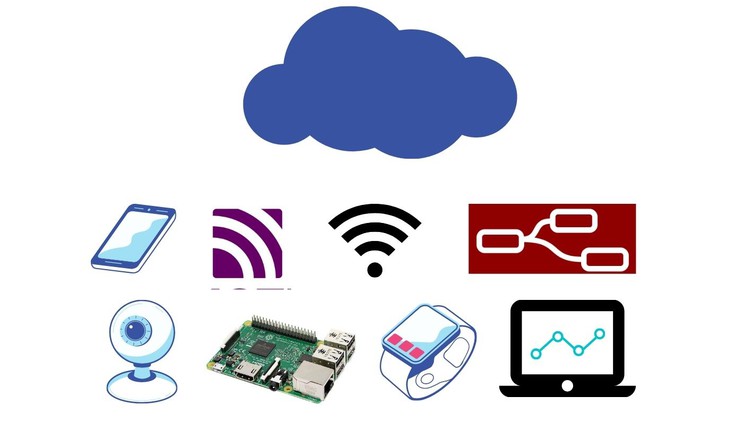Practical IoT Concepts-Devices, IoT Protocols & Servers
IoT Devices and Protocols such as MQTT, HTTP, and TCP/IP are covered. Three IoT servers are Thingspeak, Firebase, and AWS. Python, Node-Red, and Linux are three of the most popular programming languages.
What you’ll learn
Practical IoT Concepts-Devices, IoT Protocols & Servers
- The fundamentals of the Internet of Things, as well as data uploading to web servers.
- IoT Protocols such as HTTP and MQTT are implemented in a practical way.
- Node-Red Workflows and UI Dashboards
- Data is uploaded to Thingspeak, Firebase, and Amazon Web Services (AWS).
- Linux commands and the Python programming language
- Setting up a Webserver on AWS EC2 with HTML and PHP.
Requirements
-
There are no prerequisites for this course. Just a rudimentary understanding of what the Internet of Things is.
Description
IoT Architecture, IoT Devices, Amazon AWS EC2, Linux Commands, and Python are some of the highlights of the course. Python data upload to Thingspeak and Firebase, AWS MQTT Clients and MQTT Broker Uploading data to Amazon AWS EC2 via HTTP GET and POST requests, Creating a Webpage on AWS and populating it with data Create APPS with Node Red’s UI Dashboards and Node Red’s Applications.
All of these ideas, IoT protocols, and IoT servers can be implemented on any microcontroller, including Arduino, Node Red, Raspberry Pi, and Beaglebone.
This course covers all aspects of the Internet of Things (IoT) and related protocols. The IoT Architecture is discussed first, followed by the Amazon AWS EC2 Linux Instance configuration. The Linux Instance’s installs are presented next. The Linux commands and file permissions are then reviewed, and the Python language is introduced from the ground up, covering the majority of its features. The IoT protocols are next introduced, and the Firebase and Thingspeak servers are explained in detail, with data uploads demonstrated using Python programming. The HTTP GET and POST protocols are then discussed, as well as some rudimentary knowledge of HTML and PHP, which are used to generate some simple websites. Data is uploaded to Thingspeak and Firebase data servers via the HTTP GET and POST methods. The MQTT protocol is then examined in depth, as well as the various aspects of MQTT.
Practical IoT Concepts-Devices, IoT Protocols & Servers
Mosquitto is deployed in Amazon AWS and used as an MQTT Broker after the MQTT protocol is explained using third-party MQTT Brokers. Finally, Node Red is discussed, which demonstrates the integration of multiple blocks and how to use the UI dashboard to develop some incredible applications. The course concludes with a detailed explanation of how the inputs and outputs of the Node red flow are integrated. The course is designed for students who want to learn about the internet of things and all of the concepts that go along with it. The IoT Protocols are also covered in depth, and the protocols are used in the applications, with data transfer demonstrated in Python.
This course is also for working professionals who are familiar with devices but want to learn how to interface them with servers and study server side coding in order to construct a useful comprehensive application. Because we are starting from the beginning, everyone can understand the course. Even people with no prior programming experience can simply study this course because it starts from the beginning.
Practical IoT Concepts-Devices, IoT Protocols & Servers
We are utilizing Amazon AWS EC2 as the platform for writing and demonstrating different concepts in this IoT Course. A Linux Instance on Amazon AWS EC2 is a virtual server with an installed Linux operating system on Amazon AWS EC2. This instance is quite useful because it can be used as a web server, MQTT broker, Node Red Platform, and MQTT Client to send HTTP GET and POST requests. It can be used to study Linux commands, Python programming, HTML, and PHP. It can carry out all of the things that a Raspberry Pi can. As a result, we’ve chosen this Amazon AWS Linux Instance for this course because the Raspberry Pi device isn’t available to everyone. However, everything covered in this course can be done on the Raspberry Pi, and these IoT Concepts may be applied to any end-user application. These MQTT and Node Red workflows, Thingspeak server, and Firebase server concepts may be utilized with any other Microcontroller, such as a NodeMCU, Arduino, STM Microcontrollers, and so on.
Who this course is for:
- Working professionals who want to use IoT protocols to connect objects to servers.
- Students who want to create end-to-end products using IoT servers and devices.
- Students who are interested in the Internet of Things and wish to learn practical programming in the field.
- Python programmers are interested in working with IoT and integrating Raspberry Pi with servers.
- IoT enthusiasts who wish to learn more.










